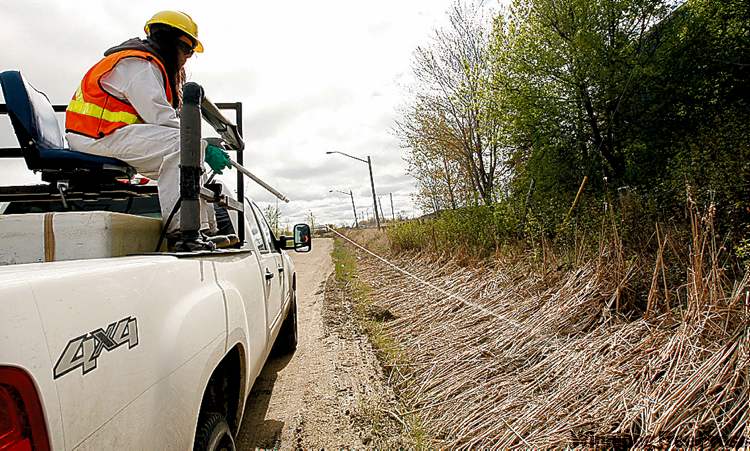City leaders itching for change
Katz, Steeves want action to strengthen battle on bugs
Advertisement
Read this article for free:
or
Already have an account? Log in here »
To continue reading, please subscribe:
Monthly Digital Subscription
$1 per week for 24 weeks*
- Enjoy unlimited reading on winnipegfreepress.com
- Read the E-Edition, our digital replica newspaper
- Access News Break, our award-winning app
- Play interactive puzzles
*Billed as $4.00 plus GST every four weeks. After 24 weeks, price increases to the regular rate of $19.00 plus GST every four weeks. Offer available to new and qualified returning subscribers only. Cancel any time.
Monthly Digital Subscription
$4.75/week*
- Enjoy unlimited reading on winnipegfreepress.com
- Read the E-Edition, our digital replica newspaper
- Access News Break, our award-winning app
- Play interactive puzzles
*Billed as $19 plus GST every four weeks. Cancel any time.
To continue reading, please subscribe:
Add Winnipeg Free Press access to your Brandon Sun subscription for only
$1 for the first 4 weeks*
*$1 will be added to your next bill. After your 4 weeks access is complete your rate will increase by $0.00 a X percent off the regular rate.
Read unlimited articles for free today:
or
Already have an account? Log in here »
Hey there, time traveller!
This article was published 23/06/2010 (5582 days ago), so information in it may no longer be current.
Amid the buzz of a civic election campaign, two of Winnipeg’s most powerful politicians hope to change the way the city fogs for mosquitoes.
This morning, Mayor Sam Katz will introduce a motion to overhaul the city’s mosquito-control program in order to speed up the time it takes to begin fogging after an emergence of adult nuisance mosquitoes.
St. Vital Coun. Gord Steeves, meanwhile, has authored a motion to re-examine the practice of placing buffer zones around homes where residents oppose the dispersal of pesticides.

Both motions, which are bound for council in some form today, are likely to prove popular among a bug-weary populace.
But they’re also being met with skepticism at city hall.
The mayor’s motion, whose precise wording was kept under wraps on Tuesday, will involve a request to re-examine the city’s entire fogging policy. Right now, several conditions must be met before trucks can begin spraying public and private property with the pesticide malathion to control mosquito species not believed to transmit diseases to people.
Before fogging trucks can hit the streets, the city must have average trap counts above 25 insects for three days straight, one quadrant of the city must have a trap count of more than 100 mosquitoes and 48 hours notice must be given to the public.
"By that time, you know what the mosquito trap counts are? In the hundreds and thousands," said Katz, surmising there must be a way to speed up the process and stop Winnipeggers from "being held hostage" inside their homes.
The mayor’s motion is not aimed at affecting the mandatory fogging ordered by the province when Manitoba Health determines the threat of West Nile virus demands the use of pesticides.
Steeves, meanwhile, wants to re-examine what he calls an "extremely volatile, divisive and misunderstood" buffer-zone policy that causes conflict between neighbours. He also believes buffer zones that extend 100 metres from any home are excessive and may not be what the provincial Clean Environment Commission ordered in 1982.
"Has it always been contemplated it would be 100 metres on each side of the property or was it 100 metres total? Have there been any technological changes that could allow us to be more specific?" he asked.
"My sense is we should be able to apply a chemical in an envelope that could suitably protect somebody in a much smaller bubble than that."
Steeves’ motion will come before council today but will be referred automatically to its protection and community services committee in July. Katz’s motion will first come to a special meeting of executive policy committee this morning and then move over to council.
Fort Rouge Coun. Jenny Gerbasi, a vocal opponent of pesticide use, said she welcomes a re-examination of fogging policy but hopes it will involve a move away from malathion toward permethrin or some other less contentious pesticide.
Katz said he already expects to see a report about phasing out malathion.
"Malathion will be a thing of the past in the very near future," he said.
But the city has been putting off replacing malathion with more expensive biological alternatives. According to city budget documents, the insect control branch intended to spend almost $4 million this year to make the transition, but the move has been put off until 2011.
"There are more progressive policies this council doesn’t want to spend money on because we are focused on tax cuts," Gerbasi charged.
Mayoral challenger Judy Wasylycia-Leis, meanwhile, ridiculed Katz.
"Wasn’t this the same guy who said he was going to get rid of mosquitoes when he ran for mayor the first time?" she asked. "Six years later, we have a more serious problem than ever before and instead of having a balanced response to people’s concerns, we have neighbours fighting neighbours."
Steeves’ motion also came under fire. North Kildonan Coun. Jeff Browaty said the St. Vital councillor had no interest in addressing mosquito fogging when a Steeves-led community services committee ignored a 2008 request by East Kildonan-Transcona councillors to re-examine buffer zones. Browaty said he wanted to eliminate the zones entirely.
The city denied a request to interview city entomologist Taz Stuart for this story.
bartley.kives@freepress.mb.ca




